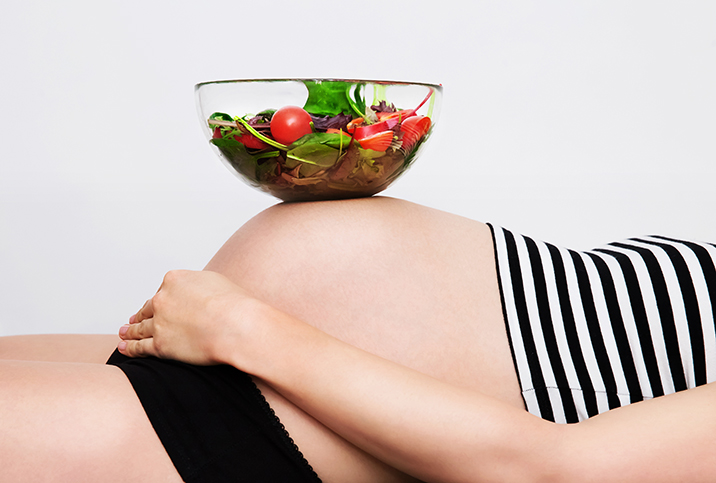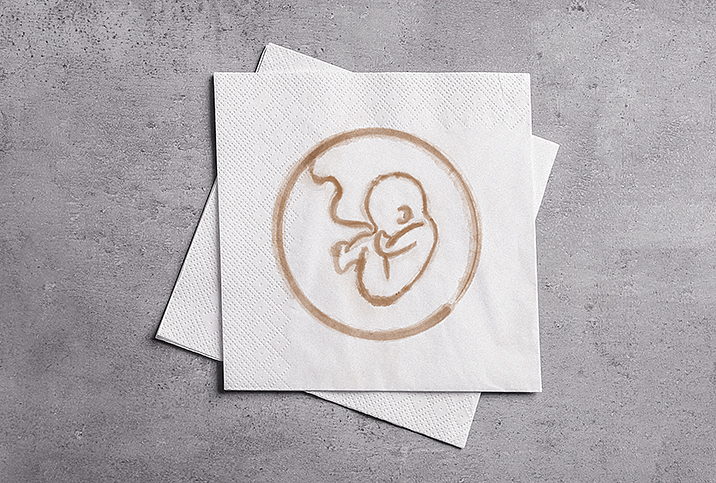What Happens If You Get Pregnant While You're Already Pregnant?

In 2021, Rebecca Roberts, of Wiltshire, England, made headlines when doctors said she had become pregnant with a second baby three weeks into an existing pregnancy. While the story may seem more like tabloid fodder than medical reality, it is not impossible.
The phenomenon, known as superfetation, is common among some species, including hares, badgers and fish. But it's incredibly rare in humans, with only 10 recorded cases to date.
"Superfetation is when you're pregnant and then you ovulate again the next month and get pregnant. So it's basically a pregnancy on top of a pregnancy that's three or four weeks apart," said Kevin Alten, M.D., an OB-GYN in Cambridge, Ohio, and co-author of a case report on a possible instance of superfetation.
While known cases are few and far between, Alten said superfetation may occur more often than we realize.
The causes of superfetation
Superfetation is the result of a sequence of unlikely events.
Normally, when a person becomes pregnant, the body initiates a series of actions to prevent a second pregnancy. This includes releasing hormones that halt ovulation and help form a mucus plug that blocks sperm from entering the cervix. The body also stops releasing certain hormones necessary to implant a fertilized egg in the womb.
For superfetation to occur, the pregnant person must ovulate, then have a second egg fertilized and implanted in the uterus along with the first one. Even if an egg makes it this far, there must be sufficient space in the uterus for it to develop.
Due to the condition's rarity, it's uncertain what causes it. However, some experts say hormonal fertility treatments, such as clomiphene citrate (Clomid), which stimulates ovulation, may increase the chances. Such treatments are used for in vitro fertilization (IVF) and in patients with polycystic ovary syndrome (PCOS).
"There are reports of ovulation occurring in the first trimester, but the likelihood of this occurring spontaneously without fertility treatments is very low," said Christine Greves, M.D., an OB-GYN at Orlando Health Winnie Palmer Hospital for Women & Babies in Florida.
Fertility treatments also increase the likelihood of having multiple births. With a spontaneous pregnancy, the chance of having twins is about 1 in 250.
How a doctor diagnoses a second pregnancy
Generally, like other types of multiple gestations, superfetation is detected with an ultrasound. Most multiples are visible by 12 weeks. However, superfetated babies are at different developmental stages, so the younger and smaller of the two may still be undetectable at the 12-week scan.
Although superfetated babies are not technically twins, the presence of multiples of any kind can increase pregnancy risks, prompting more thorough testing, said both Greves and Alten. This is when superfetation may become apparent.
"We follow twins by checking their growth by ultrasound, so if they're not matching up to be a similar gestational age, this finding is incredibly rare, but [superfetation] is a possibility," Greves said.
A discrepancy in fetal development is known as growth discordance. Superfetation is just one possible, highly unlikely reason it can occur. More common causes include placental insufficiency, when the placenta does not develop correctly, and uneven blood distribution between twins.
One specific case
In Alten's case study, at 12 weeks, the patient received a cell-free DNA test, a customary form of noninvasive prenatal testing, which yielded unexpected findings.
This assessment, which involves drawing a blood sample from the pregnant person, has become the go-to prenatal test for conditions such as Down syndrome. Previously, the only ways to test for chromosomal abnormalities were amniocentesis and placental sampling, both of which carry substantial risks.
"Basically, you draw a sample of the mom's blood and you're looking for fetal cells in the blood," Alten said, describing the DNA assessment. "There is some escape of fetal cells into the maternal bloodstream, so you can get some of the baby's chromosomes from mom."
Alten said the patient's doctors did not realize there were two babies in the womb at the time, as the smaller of the two babies had not been detected during the first ultrasound at seven weeks. This made the cell-free DNA test results confusing due to the unusual number of cells and chromosomes.
Initially, according to Alten's report, the doctors suspected the results may indicate a vanishing twin, unrecognized multiple gestations or increased risk of fetal triploidy, which occurs when the developing baby has an extra set of chromosomes. The patient had her next ultrasound at 19 weeks, at which time the second baby was discovered.
For superfetation to occur, the pregnant person must ovulate, then have a second egg fertilized and implanted in the uterus along with the first one.
"Part of the reason we think our case is superfetation is the second baby was always smaller than the first baby, but that's to be expected because that baby is three or four weeks behind," Alten said. "These babies grew normally, just one was always behind the other because it was three weeks younger."
In most cases, doctors perform another ultrasound immediately after an unusual cell-free DNA test result, Alten said.
"It may even have been a more clear-cut case of superfetation if she'd had an ultrasound at 12 or 13 weeks," he said.
Alten explained the patient's rural location, which was some distance from a tertiary care facility, likely prevented her from receiving a timelier follow-up.
The risks of superfetation
Greves and Alten said multiple gestations of all kinds are considered high risk, with a greater likelihood of complications, including hypertension, anemia and miscarriage.
"There's no cookbook on how to proceed with [superfetation], so you'd definitely want to have a high-risk management team helping," Greves said.
Incorrect diagnosis is another distinct danger, according to Alten.
"The big risk is not making a correct diagnosis, thinking there's something wrong with the second baby as opposed to it just being younger and having to deliver the baby early because you're worried there's a problem with it," Alten said.
In Alten's case report, the patient's initial doctors suspected fetal triploidy, a lethal condition, in the second baby and advised her to consider terminating. The patient sought a second opinion. Her new medical team reevaluated the initial tests and ran new ones. They ruled out triploidy and determined both pregnancies were viable.
Preterm labor and birth is another risk heightened with superfetation. Over 60 percent of twins and almost all higher multiples are born preterm, according to Johns Hopkins Medicine. But the different gestational ages in superfetation make it likely one baby will be three to four weeks premature, even if their sibling is delivered at term.
The patient in Alten's case study had to deliver early due to complications, including hypertension. After several weeks of close observation, doctors became concerned about the babies' well-being and delivered via cesarean section at 28 weeks and three days. Both babies spent considerable time in the neonatal intensive care unit—160 and 192 days, respectively—but ultimately emerged healthy. Roberts' children, and others described in case studies on the matter, also progressed favorably.


















